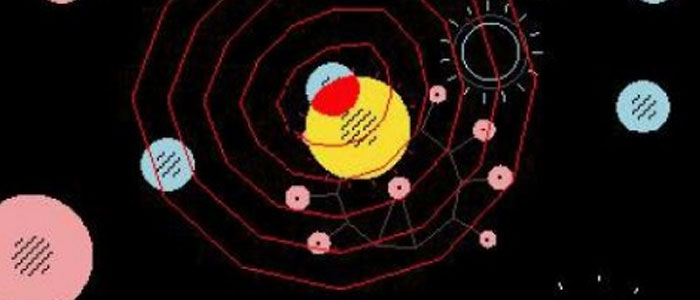Already selected as one of Apple’s 30 faves, I am coming a little late to the Eliss party. At first launch, Eliss did not win me over. Actually, if I didn’t have friends with the game with whom I am fiercely competitive I don’t think I would have even hit “Retry” after the first miserably failed Sector. Instructions are minimalist, graphics more so, and my defeat so rapid that the gameplay had only a matter of seconds to work its limited charms. Fifteen sectors later, I wholeheartedly agree that Eliss delivers an uncommon gaming experience.
Its challenge is described as keeping “harmony in an odd universe made of bendable planets”. Replace “bendable” with “divisible” and you will get a better idea. Planets are pastel colored orbs that can be combined with like colors or split into dwarf planets with easy touch controls. What you live in constant fear of are planets of unlike colors coming into contact; this will drain your energy meter which is tracked in the upper left. In addition to reducing this bar to nothing in a matter of seconds, letting two planets collide will cause the newer of the two orbs be shaved down to a smaller size as long as they remain in contact.
Squeesars appear, and placing planets of the right color and size within them causes the planets to explode in a supernova spraying stardust, which you can tap to regain some health. Each level requires a fixed number of these squeesars be filled to advance to the next Sector. “Enemies” is too plebeian a word for a game like Eliss, but there are spiralling red stars that are incompatible with all planet colors and whirlpools that suck the orbs and planetary shrapnel to their centers. There are also tokens that will occasionally drift onscreen: one that slows things down and another that restores energy.
Once you figure out the gameplay, the pinch and spread touch controls are a snap, but “multi-touch” starts to sound like an understatement when you are propping your phone on your knees and using both hands to guide the orbs around the screen. Completing all twenty sectors? Profanity is certain, bodily harm likely and impossible it may well be. Eliss falls into that category of games whose addiction thrives on their own masochism.
Words like “pure” get tossed around, assigning virtue to its Puritanical brutality. New orbs birth right beneath another color, whirlpools drag them toward each other with cruel magnetism and red stars attack with glacial force. You start to wonder if you missed a few levels, the ones that sort of ease you into the torture – then, suddenly you solve the puzzle and are tackling the next level with vigor.
The pace becomes frantic by Sector 5, but since the vector text menu makes no delay between launch and level you can count on gliding just as seamlessly from Game Over to Retry. Created by digital media designer Steph Thirion, Eliss is impressive in its style. It’s not an overworked game; its retro spareness speaks volumes as an electronica score thumps in time to the multiplying planets, a perfect match for the stark presentation.
Mandatory multi-touch controls make this game all iPhone. Manual dexterity of a neurosurgeon and remarkable focus are required, so challenging is Eliss that only the hardcore need apply. If I could make a comparison it would be to Shadow of the Colossus. Like SotC, the mechanics of Eliss are simple and each stage challenges your perceptions of the game. You must determine how to conquer a particular Sector, and then execute the strategy – and I think that’s cool. Serious, brutal, and ice cold in delivery Eliss doesn’t make the best first impression but delivers an excellent and above all, unique, action puzzler.
